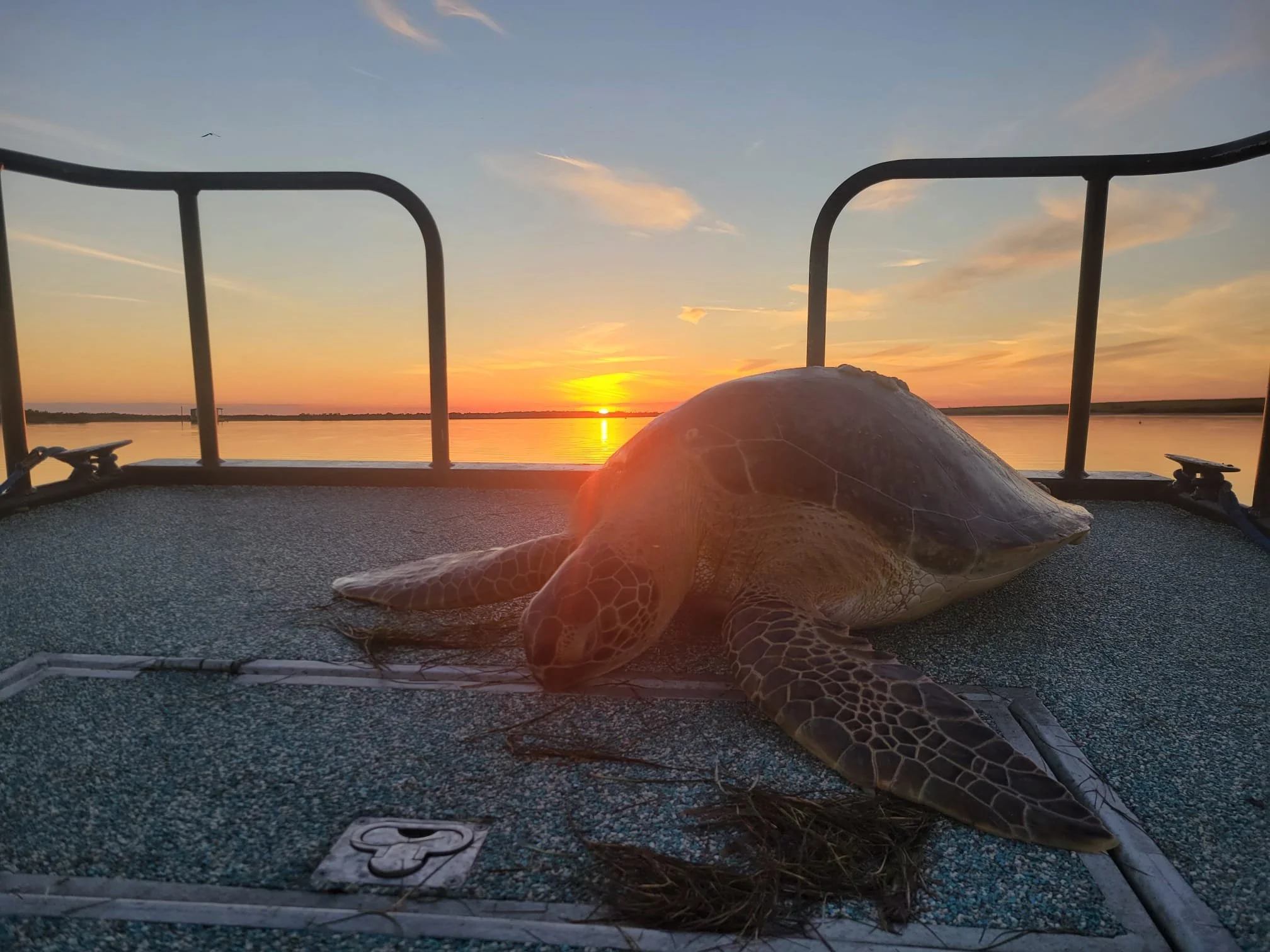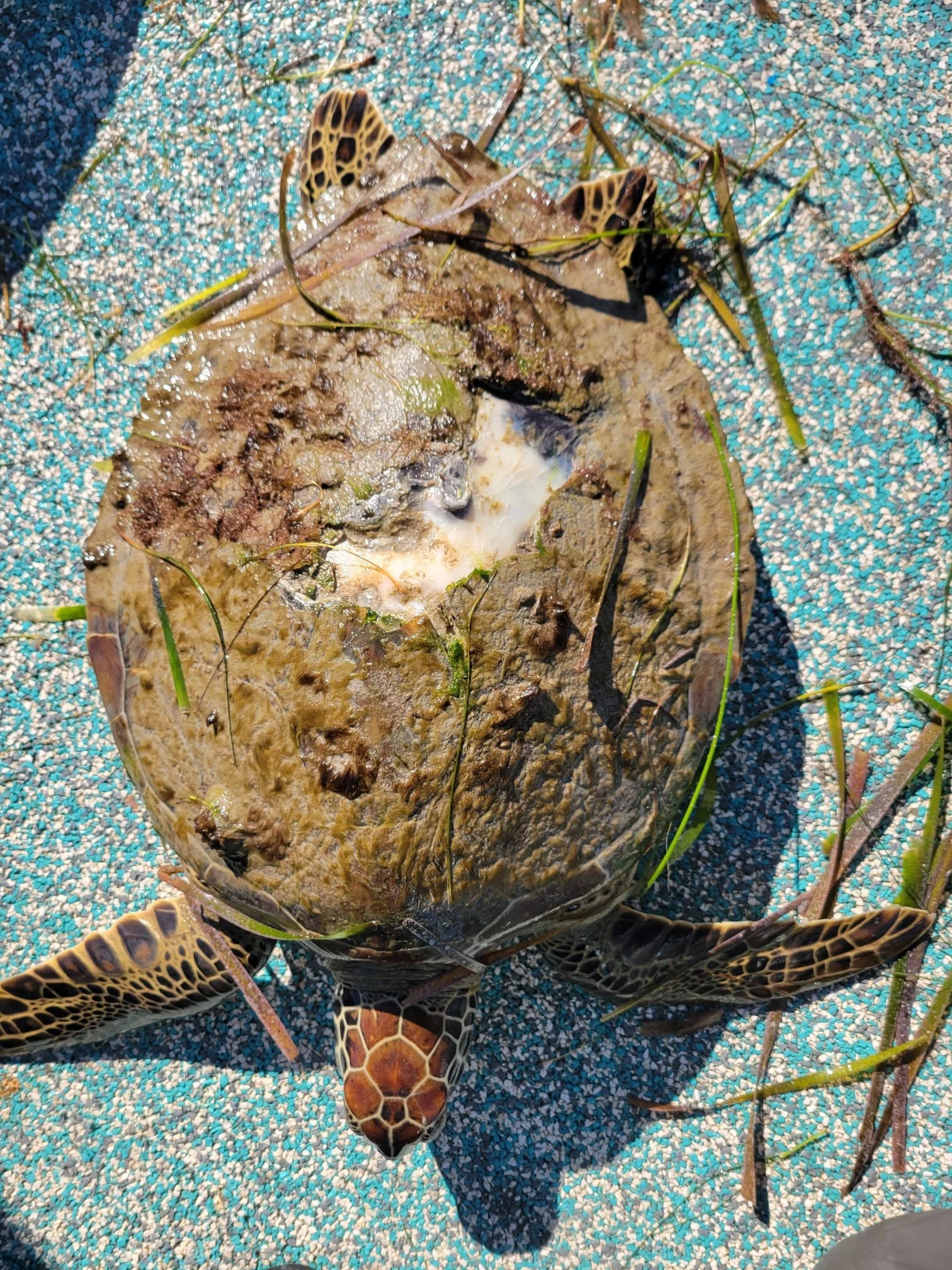Emergency Rescue: Saving Cold-Stunned Sea Turtles in the Lower Laguna Madre
A sudden cold front swept through the Lower Laguna Madre, turning the normally mild waters around South Padre Island and the Arroyo Colorado into a dangerous environment for local sea turtles. As the temperature dropped unexpectedly, many turtles became cold-stunned—a condition that leaves them sluggish, disoriented, and vulnerable to life-threatening complications. Recognizing the urgency of the situation, conservation organizations, government agencies, and volunteers mobilized quickly to prevent further casualties.
A rescued green sea turtle rests on the boat at sunset, symbolizing resilience and hope for its return to the wild. Photo Credit: Justin LeClaire
On January 21, 2025, Conservation Biologist Justin LeClaire of the Coastal Bend Bays & Estuaries Program reached out to Eric Cantu, President and Aquatic Ecologist at Southern Research and Compliance LLC (SRC), for assistance in rescuing cold-stunned sea turtles. Over the following days, SRC joined forces with other conservationists, using their expertise in environmental monitoring to locate and retrieve affected turtles. Once rescued, the turtles were carefully transported to Sea Turtle, Inc. volunteers and staff for rehabilitation, ensuring that each one had the best chance of survival.
Eric Cantu, President of Southern Research and Compliance, assists in the rescue of cold-stunned green sea turtles near South Padre Island, Texas. Photo Credit: Justin LeClaire
What is Cold-Stunning and Why is it Dangerous?
Cold-stunning occurs when sea turtles experience prolonged exposure to low temperatures, causing their body functions to slow dramatically. Their metabolism drops, rendering them unable to swim, feed, or escape predators. Stranded turtles often float motionless at the surface, leaving them susceptible to boat strikes, drowning, and predation. Additionally, long-term exposure can weaken their immune system, leading to secondary infections, pneumonia, or even death. In the shallow waters of the Laguna Madre, sudden temperature drops can be particularly harmful, making swift rescue efforts critical for their survival.
A rescued green sea turtle with visible boat strike injuries on its shell, a potential result of prolonged immobility due to cold-stunning.
Coordinated Rescue Efforts
The rescue operation involved multiple organizations, including Sea Turtle, Inc., Texas Parks and Wildlife, and a dedicated network of volunteers. As teams worked together to locate distressed turtles, they transported them to specialized rehabilitation facilities, where they were gradually warmed and closely monitored. Only after regaining their strength and health would they be released back into the wild.
Conservation Biologist Justin LeClaire carefully arranges cold-stunned sea turtles on the boat before transferring them for medical evaluation.
How SRC’s Experience Strengthens Conservation Efforts
Hands-on involvement in wildlife rescue and habitat restoration directly enhances SRC’s approach to environmental management. Field experience with events like this deepens our understanding of complex ecological systems, allowing us to offer more effective services such as habitat assessments, regulatory compliance assistance, and ecosystem monitoring. These real-world experiences enable us to develop practical solutions that align with both conservation goals and regulatory requirements.
Eric Cantu and Justin LeClaire transport cold-stunned green sea turtles to safety for rehabilitation after a sudden temperature drop in the Lower Laguna Madre.
Successful Release: Sea Turtles Returned to the Wild
After weeks of rehabilitation, the rescued sea turtles were successfully released back into their natural habitat on January 26, 2025. Sea Turtle, Inc. organized a public event at Cameron County Beach Access 4, where conservationists and supporters gathered to witness the turtles make their way home. Watching these turtles return to the ocean served as a powerful reminder of the importance of conservation, quick response efforts, and community involvement in protecting vulnerable marine life.







Photos taken from the Sea Turtle Inc. January 26, 2025 Facebook Post.
How You Can Help
Anyone can be part of the solution. Whether through hands-on volunteering, spreading awareness, or supporting conservation programs, small actions can make a lasting impact on sea turtle survival. If you’d like to get involved, visit Sea Turtle, Inc. and Texas Parks and Wildlife for opportunities to participate in rescue efforts, training programs, or educational outreach.
Together, we can protect the fragile ecosystems of the Laguna Madre and ensure that sea turtles continue to thrive in the wild.
Eric Cantu lifts a cold-stunned sea turtle onto the boat, ensuring its safe recovery and transport.
A rescued Chelonia mydas (green sea turtle) shows signs of cold-stunning as it awaits care from rehabilitation experts.
About the Authors
Eric Cantu
President, Aquatic Ecologist, and Co-founder of Southern Research and Compliance LLC (SRC)
M.S., Biology, The University of Texas Rio Grande Valley
Victoria Cantu
Co-founder of Southern Research and Compliance LLC (SRC)
M.S., Biology, The University of Texas Rio Grande Valley
Refrences
Sea Turtle, Inc. (n.d.). Cold Stun Events. Sea Turtle, Inc. Retrieved from https://seaturtleinc.org/cold-stun/
KRGV. (2025, January 22). Hundreds of cold-stunned turtles recovering at Sea Turtle, Inc. KRGV. Retrieved from https://www.krgv.com/news/hundreds-of-cold-stunned-turtles-recovering-at-sea-turtle-inc-/
ValleyCentral. (2025, January 26). Sea Turtle, Inc. releases over 350 turtles back into Gulf of Mexico. ValleyCentral. Retrieved from https://www.valleycentral.com/news/local-news/sea-turtle-inc-release-over-350-turtles-back-into-gulf-of-mexico/
Texas State Aquarium [@txstateaquarium]. (2025, January 21). Cold weather impacts sea turtles along the Texas coast. [Instagram post]. Instagram. Retrieved from https://www.instagram.com/p/DFGf1EtNJZS/









